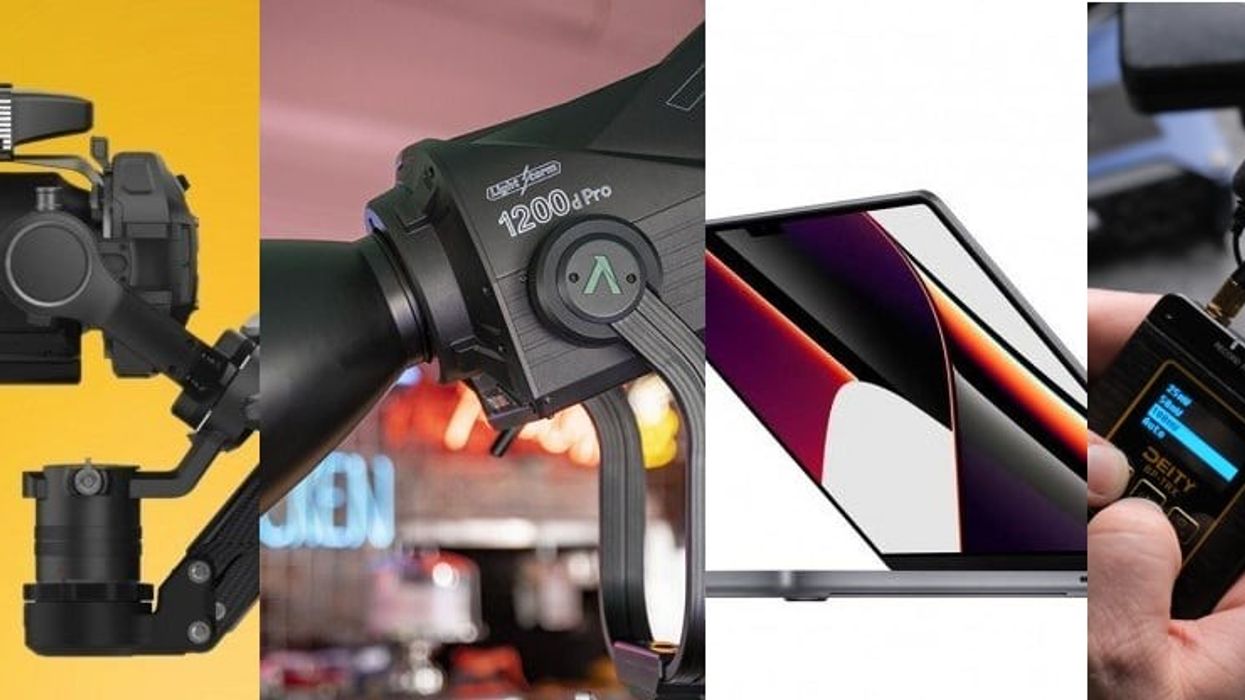Let's Walk Through the Best of 2021 Tech
How does this year's new tech help filmmakers?

If there is a theme to the year in film tech, we're going to go with the "smoosh," or combining discrete technologies to make things better for users.
It's always a bit forced to make a year have a theme; you're looking at a landscape and trying to boil it down to its essentials, but you have to ignore an outlier. Luckily, this year the theme is actually pretty obvious, and frankly, the theme is "smooshing." All the big changes filmmakers are experiencing with tech this year come from disparate technologies getting pushed together to make something more useful for filmmakers.
There's nothing wildly new out this year, but things are better, easier, and faster through "smooshing."
Apple M1 Max
While the original Apple Silicon M1 Macs started shipping last December, the big news for filmmakers was the release of the M1 Pro and Max Macbook Pros this fall. They are just screamingly, ridiculously fast.
As talked about in our review, we put together a Blackmagic 12K RAW sequence, put on a bunch of noise reduction (which is processor intensive), and hit "render" on a bunch of machines. Our old Intel MacBook Pro with an NVIDIA chip never even started the render after eight hours of waiting. Last year's Pro took two hours.
The new machine took 7 minutes. They are fast.
They are a "smoosh" for two big reasons. First off, Apple Silicon is taking the ARM architecture, which grew to strength on mobile platforms, and is smooshing it into the desktop format. But more than that, they are smooshing together graphics and video processors into a single system.
Instead of a computer with a CPU and a GPU (central processing unit and graphics processing unit), there is a single brain that, most importantly, shares memory. All the system RAM is available for both types of processes. We suspect this is really why you get such jaw-dropping power out of the systems.
Apple is back.
DJI Ronin 4D
The next big release this year is absolutely the DJI Ronin 4D. It's a camera we can't stop thinking about.
And it is absolutely another sign of a "smoosh." DJI took its amazing work on stabilizing cameras for drones and created a back-end for the camera that works as a modern cinema camera body. The 4D represents one of the first real innovations in camera design of the digital era.
The first digital cinema cameras looked a lot like traditional film cinema cameras. It helped folks transition over to the new methods of working with something that felt familiar. But the 4D is a real attempt to push things forward in a way that will allow people to create shots that would've been prohibitively difficult before with smaller teams and faster speed.
As a new platform, there are going to be some limits, but we can't wait to see how this changes the landscape over the next few years.
Deity BP-TRX
This news didn't get nearly enough traction when it launched, but one of our favorite items of the year was the flexibility you get out of adding timecode to the Deity TRX units. Combining the ability to be a transmitter or a receiver, and the ability to work as a director's monitor, and the ability to record locally, and the ability to do timecode, these little units are truly smooshing together so many features—it's insane.
The beauty of all this smooshing is that it makes the gear more flexible not just on an individual shoot, but as you go job-to-job.
On a shoot where you need to run four lavaliers for four actors talking in a scene? Great, you're set.
On the next job are there only two actors? Instead of those lavaliers sitting in your kit, you can turn one into a director's monitor.
Book a multi-camera job? You can use the timecode output for sync.
Getting to use the same little boxes for different things won't help you much on a single day (it's rare you're going to use it for lavalier in the morning and timecode in the afternoon, though I bet it happens), but it will make the units more useful as you move through gigs.
The Exception: LEDs Get More Powerful
If there is an exception to the trend, it's that the other thing we've seen and loved this year is LEDs getting a lot more powerful.
This isn't really a smoosh, just taking something we already liked and turning up the dial. Tech tends to have times where it gets better, then times when it plateaus, and LED tech is absolutely not in a plateau right now. Outputs, color accuracy, and cooling are all going up in ways we just wildly appreciate.
The big headlines here for us have been the LS 600x Pro hitting the streets and the new Double Rainbow and Rainbow 2 units from Quasar. Both take very similar form factors to earlier units from the manufacturers, but up the output.
Output isn't everything, of course. For a lot of shoots, you don't need every single available photon. But sometimes you do, and having LED units really start to feel like they are giving us some real proper sand is a big feeling about this year.
What Do We Dream for 2022?
What are we thinking about for 2022? We're hoping lens manufacturers take the challenge of the DJI 4D and start rolling out lens sets that work within its limitations, giving us more choices with the platform.
We're very curious to see what Apple does with an Apple Silicon desktop Mac Pro.
And we're all hoping for more fun, creative time making projects.
What are you hoping for in upcoming tech? Any big things from this year you feel like we missed?
Check out weekly specials, deals, and rebates: Pro Video Gear, Pro Audio Gear, Lighting















